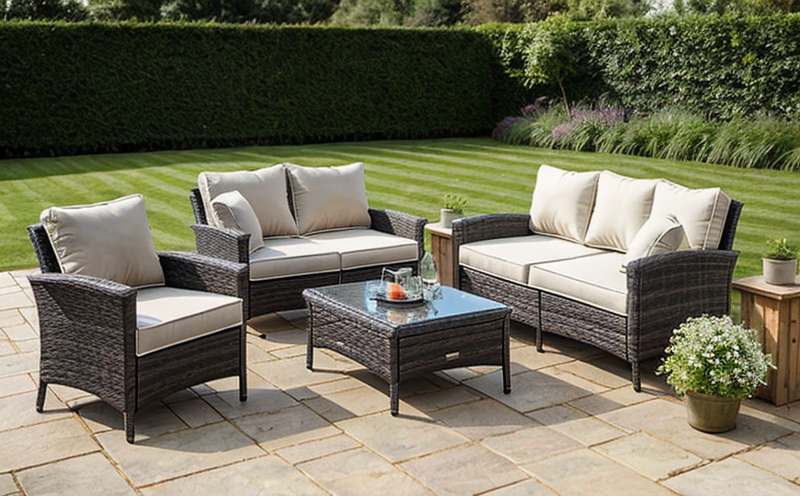Outdoor & Garden Furniture Testing
The testing of outdoor and garden furniture is crucial to ensure that these products meet safety standards, durability requirements, and environmental sustainability expectations. This testing encompasses a wide range of materials such as wood, metal, plastic, wicker, and composite materials commonly used in the production of outdoor seating, tables, benches, and other garden furniture.
Outdoor and garden furniture is exposed to harsh environmental conditions that can significantly affect its performance over time. These conditions include exposure to sunlight, rain, humidity, extreme temperatures, and various types of pollutants. Therefore, testing these products ensures their longevity and reliability in outdoor environments. This includes evaluating the resistance to weathering, UV radiation, mold growth, and insect infestations.
For quality managers and compliance officers, ensuring that outdoor furniture meets relevant standards is essential. These standards include international norms such as ISO, ASTM, and EN. Compliance with these standards can help avoid potential legal issues and enhance the reputation of manufacturers. R&D engineers benefit from detailed testing as it helps them optimize product design, improve material selection, and refine manufacturing processes.
In addition to durability, safety is a paramount concern in outdoor furniture testing. Tests are conducted to ensure that products do not pose any risks to users or the environment. This includes assessing load-bearing capacities under various conditions, stability on uneven surfaces, and the presence of sharp edges or protrusions that could cause injuries.
For procurement teams, selecting suppliers who provide high-quality outdoor furniture involves thorough testing reports. These reports not only help in making informed decisions but also ensure compliance with company policies and industry standards. Compliance officers need to be aware of these tests as they play a crucial role in maintaining regulatory compliance across the supply chain.
The primary goal of outdoor and garden furniture testing is to provide manufacturers, suppliers, and purchasers with reliable information about product performance under real-world conditions. This allows for better decision-making processes that enhance both quality assurance and sustainability practices within the industry.
Scope and Methodology
| Test Parameter | Description |
|---|---|
| Weathering Resistance | Testing for exposure to UV radiation, rain, humidity, and temperature fluctuations. |
| Mold Growth Inhibition | Evaluating the effectiveness of materials in preventing fungal growth. |
| Insect Infestation | Assessing resistance against common insects like termites and ants. |
| Load Capacity | Determining how much weight a piece of furniture can safely support without failing. |
| Stability on Uneven Surfaces | Evaluating the stability of furniture when placed on various surfaces, including grass and concrete. |
| Sharp Edges and Protrusions | Checking for any sharp edges or protrusions that could pose a safety hazard. |
| Mechanical Strength | Testing the strength of joints, screws, and other connecting elements. |
| Colorfastness to Light | Determining the ability of paint or finishes to resist fading due to exposure to sunlight. |
The methodology for testing outdoor furniture involves a combination of laboratory-based and real-world simulations. Laboratory tests provide controlled conditions where specific parameters can be precisely measured, whereas real-world simulations allow for the evaluation of how products behave under actual environmental conditions. Both approaches are essential in ensuring comprehensive coverage of potential issues.
Benefits
The benefits of thorough outdoor and garden furniture testing extend far beyond just meeting regulatory requirements. By undergoing rigorous testing, manufacturers can enhance their product’s reputation for reliability and safety, which is particularly important given the public nature of these products. This increased trust from consumers can lead to higher sales volumes and customer loyalty.
Moreover, sustainable practices are becoming increasingly important in today’s market. Testing contributes significantly to reducing waste by identifying weak points early on during development stages, thus preventing unnecessary production runs or recalls later down the line. It also helps companies comply with growing demands for eco-friendly products without sacrificing performance.
For quality managers and procurement officers, knowing that suppliers adhere strictly to testing protocols ensures consistent product quality across batches and reduces risks associated with poor-quality materials. Compliance officers find peace of mind knowing they are supporting responsible business practices that align with broader social expectations.
Environmental and Sustainability Contributions
Eco-friendly materials play a critical role in sustainable outdoor furniture production. Testing these materials helps identify which ones perform best while minimizing environmental impact. For instance, recycled plastics or bamboo offer significant advantages over traditional wood because they consume fewer resources during manufacturing processes and are easier to recycle at the end of their lifecycle.
Testing also plays a vital part in promoting responsible sourcing by encouraging manufacturers to choose sustainable materials sourced locally whenever possible. This reduces transportation emissions while supporting local economies. Additionally, testing ensures that products designed for longevity contribute positively towards reducing waste in landfills.
The environmental impact assessment (EIA) of outdoor furniture involves evaluating various aspects such as energy consumption during production, water usage, air pollutants generated throughout the supply chain, and disposal methods after use. By incorporating these factors into design decisions early on, manufacturers can significantly reduce their overall carbon footprint.





